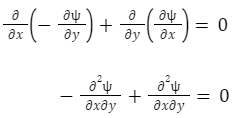The streamline function is a scalar function of space and time that provides the velocity component at sharp angles to any direction when its partial derivative is calculated with respect to that direction. The streamline flow is also called laminar flow. It is exclusively defined for two-dimensional flow and is indicated by Ψ(Psi). In material terms, steady flow can be defined as,
The velocity components in cylindrical coordinate in terms of streamline function are given as,
Where ur is the radial velocity and uθ is the tangential velocity.
The continuity equation for two-dimensional flow will be given as ,
Put the values of u and v, then we get,
Hence, existence of means a possible case of fluid flow. The flow may be rational or irrotational. The rotational component ωz is given as,

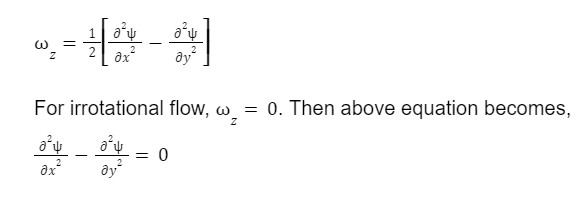
Where Ψ is the Laplace equation.
For example – A streamline function is given as Ψ =5x-6y. Calculate the velocity, magnitude, and direction of the resultant velocity at any point.
Solution:
Given, ψ =5x-6y
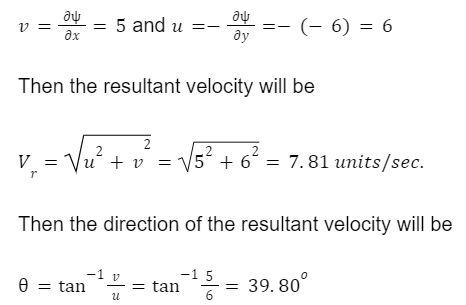
The properties of a streamline function () are as follows;
If the stream function () exists, it indicates a possible scenario of rotational or irrotational fluid flow.
It is a conceivable case of an irrotational flow if the stream function () fulfils the Laplace equation.
Advantages of the streamline flow
The energy loss in the streamline flow is very less.
The streamline flow reduces the energy consumption in pumping of water.
There is a little friction between the liquid layers.
Laminar flow and turbulent flow
Laminar flow – When a fluid flows layer by layer, this type of flow is called laminar flow. Molecules in one layer do not mix with those in other layers of the fluid. The flow is also called the streamline flow or viscous flow. In the flow, viscosity is significant.
Turbulent flow – When a layer of a fluid gets mixed up with the other layer of the fluid, it is called turbulent flow.In the flow, a particle of the fluid moves in an irregular manner.
Difference between streamline flow and turbulent flow
Streamline flow | Turbulent flow |
|---|---|
In streamline flow, all the layers of the fluid are parallel. | In turbulent flow, all the layers of the fluid are not parallel. |
The velocity or speed of the fluid is low and steady and less than the critical velocity. | The velocity or speed of the fluid is high and unsteady and more than critical value. |
The velocity at a specific point remains constant for every particle. | The velocity at a specific point changes for every particle. |
The particles of the fluid do not apply the pressure on the system in which they flow. | The particles of the fluid apply the pressure on the system in which they flow. |
There is no mixing of the layers. | There is mixing of the layers. |
Relation between the streamline function and velocity potential function
We know that the velocity potential function is given as,
We know that the streamline function is given as,

For example – The velocity potential function is given as Φ =2xy. Find the velocity at the point (3, 4). Define the streamline function at point P.
Solution:
Given, Φ = xy
The velocity components in the direction of x and y are,
At the point P(3, 4), we have,
u=-2×4=-8 units/sec
v=-2×3=-6 units/sec
The velocity at point P will be,
=-6i-8j
The resultant velocity at point P will be,
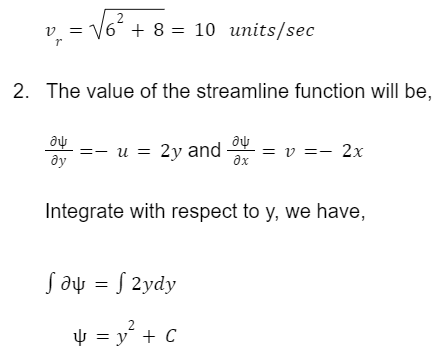
The constant of integration C is not a function of y but it can be a function of x. Then differentiate the above equation with respect to x, we have,
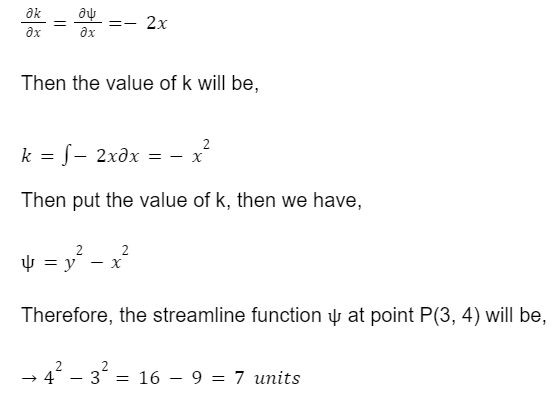
Conclusion
It is very important to know the flow is streamline or turbulent. If the flow is streamline, then all the theories of laminar are to be applied for the designing. And if the flow is turbulent, then all the theories of turbulence are to be applied for the design.
 Profile
Profile Settings
Settings Refer your friends
Refer your friends Sign out
Sign out







